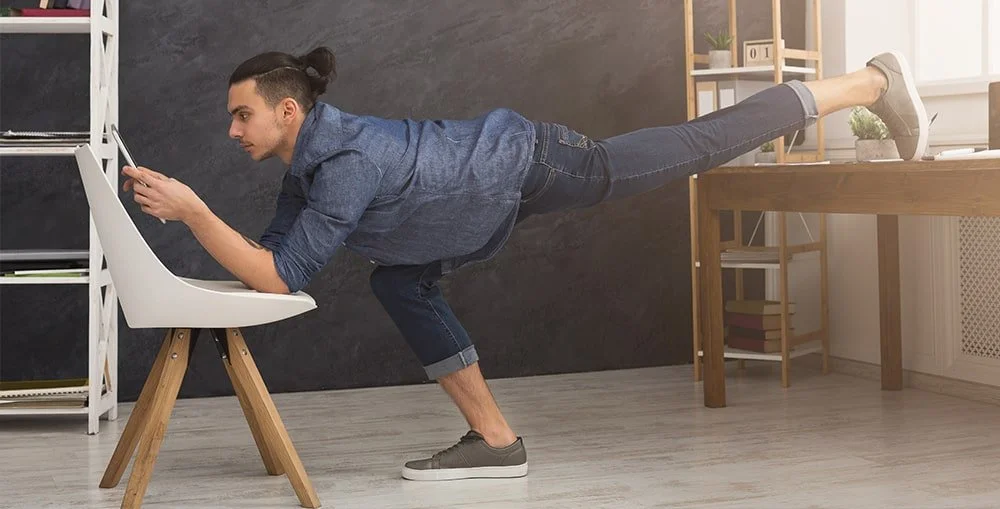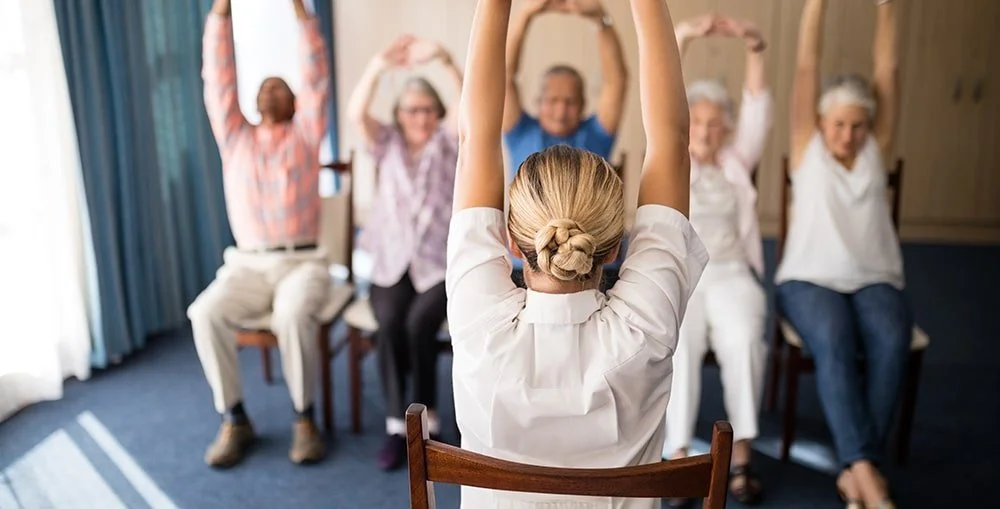Sit, Stretch, Smile: What Is Chair Yoga's Secret Power?
Table of Contents Show
Quick Summary
Curious about chair yoga but not sure if it's worth your time? Our latest article dives deep into this trendy exercise method, exploring its surprising benefits for people of all ages and abilities. Discover how just a few minutes a day could improve your flexibility, strength, and even your mood.
We'll guide you through simple poses you can do anywhere and explain the science behind the practice. Whether you're a senior, an office worker, or just looking for a gentle way to stay active, this article might just inspire you to give chair yoga a try. Ready to learn how a simple chair could become your new favourite fitness tool?
TL;DR – What Is Chair Yoga?
Chair yoga is a gentle form of yoga done while seated or using a chair for support.
It’s ideal for beginners, seniors, or anyone with limited mobility or balance concerns.
The practice includes stretches, breathing exercises, and mindful movement.
It can improve flexibility, reduce stress, and support joint and muscle health.
A safe, accessible way to enjoy the benefits of yoga—anytime, anywhere.
Ever heard of chair yoga? If you're picturing a group of people awkwardly contorting themselves around office furniture, you're in for a pleasant surprise!
Chair yoga is actually a gentle, accessible form of yoga that's taking the wellness world by storm.
But what is chair yoga, exactly?
It's a modified yoga practice where poses are performed either sitting on a chair or using a chair for support. Whether you're a senior looking to improve flexibility, an office worker battling the 9-to-5 slump, or someone curious if chair yoga is effective for weight loss, this versatile practice has something for everyone.
So, pull up a seat (pun intended), and let's dive into the world of chair yoga – where comfort meets fitness in the most unexpected way!
Not Your Average Yoga Class
Picture this: You walk into a yoga studio, expecting to see a sea of colourful mats and lithe bodies stretching into impossible poses. Instead, you find a room full of chairs and people of all ages and abilities, smiling and moving with surprising grace. Welcome to the world of chair yoga!
Chair yoga isn't about squeezing yourself into a pretzel shape while perched on an office chair (though that might make for an interesting YouTube video). It's a thoughtful adaptation of traditional yoga that makes the practice accessible to everyone. By using a chair as a prop, either to sit on or to provide support and balance, chair yoga opens up a world of wellness to those who might have thought yoga was out of reach.
But who exactly is chair yoga for? The beauty of this practice is its versatility. It's ideal for seniors seeking to enhance their flexibility and balance without the risk of falls. Office workers can use it to break up long days of sitting and combat the effects of a sedentary lifestyle.
Even athletes recovering from injuries can benefit from the gentle, supportive movements. And for those who find traditional yoga intimidating? Chair yoga provides a gentle, non-competitive introduction to mindful movement.
The Surprising Perks of Parking Yourself in a Chair
Let's talk about something truly exciting - chair yoga. OK, I know that does not sound right, and I know what you might be thinking. "Yoga? In a chair? How effective can that really be?" Well, prepare to have your mind blown!
We've got some fascinating research that shows just how powerful this simple practice can be. A study published in the journal Healthcare in 2023 looked at older women with knee osteoarthritis who tried chair yoga. The results? Nothing short of amazing.
This isn't just about stretching or passing the time. We're talking about real, measurable improvements in people's lives. And the best part? You can do this anywhere you've got a chair.
At home, at work, even while waiting for your coffee to brew! So, are you ready to discover how a humble chair could be your ticket to better health? Let's dive in and explore what this research tells us about the power of chair yoga.
-
Chair yoga isn't just about gentle stretching - it can lead to real, measurable physical improvements. A study published in Healthcare found some impressive results after just 12 weeks of chair yoga practice:
Improved Flexibility: Participants showed significant gains in lower body flexibility. This could mean easier movement in daily activities, from tying your shoes to reaching for objects.
Better Balance: The study reported enhanced static balance among participants. Improved balance can reduce the risk of falls, a crucial benefit for older adults.
Increased Strength: Both upper and lower body strength improved. Stronger muscles can make everyday tasks easier and help maintain independence.
Enhanced Functional Fitness: Chair yoga improved participants' ability to perform daily life activities. This suggests that regular practice could help maintain or even improve your overall physical function.
-
While the PubMed study focused primarily on physical outcomes, it hinted at some mental and emotional benefits:
Reduced Fear of Falling: Participants reported less fear of falling after the chair yoga program. This increased confidence can lead to greater independence and willingness to engage in activities.
Potential Stress Reduction: Although not directly measured in this study, other research has shown that yoga practices, including chair yoga, can help reduce stress and anxiety levels.
-
One of the most significant advantages of chair yoga is its accessibility:
No Special Equipment Needed: All you need is a sturdy chair. This makes chair yoga an option for almost anyone, anywhere[1].
Adaptable to Various Abilities: The study focused on older women with knee osteoarthritis, demonstrating that chair yoga can be beneficial even for those with mobility limitations.
Easily Integrated into Daily Life: Whether you're at home, at work, or even waiting for an appointment, you can practice chair yoga. This flexibility makes it easier to maintain a consistent practice.
Improved Flexibility
Significant gains in lower body flexibility make daily activities easier, such as tying your shoes or reaching for objects.
Better Balance
Enhanced balance can reduce the risk of falls, especially for older adults.
Increased Strength
Upper and lower body strength improvements make daily tasks easier and help maintain independence.
Enhanced Functional Fitness
Chair yoga improves the ability to perform daily life activities, maintaining overall physical function.
Reduced Fear of Falling
Participants felt less fear of falling, leading to more confidence and greater independence.
Potential Stress Reduction
Chair yoga may help reduce stress and anxiety, making you feel more relaxed.
No Special Equipment Needed
A sturdy chair is all you need, making it accessible for anyone, anywhere.
Adaptable to Various Abilities
Even for individuals with mobility issues, chair yoga is beneficial and adaptable.
Easily Integrated into Daily Life
You can practice chair yoga anywhere—at home, work, or while waiting for an appointment.
Chair yoga proves that you don't need complex equipment or extreme flexibility to reap the benefits of yoga. It's a practice that meets you where you are, whether in your living room, office, or anywhere else you can find a chair. So why not give it a try? Your body (and mind) might thank you!
Getting Started with Chair Yoga
Ready to give chair yoga a try? Great! The best part is, you don't need much to get started. You probably already have everything you need at home or in your office. First things first, let's talk about equipment. Spoiler alert: it's not much!
All you really need is a sturdy chair. Skip the wheeled office chairs or overstuffed recliners - a simple, stable chair without arms is perfect. This gives you the freedom to move without restrictions.
Now, if you're thinking, "But I'm not flexible enough for yoga!" - stop right there. That's the beauty of chair yoga. It meets you exactly where you are.
Whether you're a fitness newbie or dealing with limited mobility, chair yoga is adaptable to your needs and abilities.
Here are a few tips to help you get started:
Find a quiet space where you won't be disturbed.
Wear comfortable clothing that allows you to move freely.
Start with just a few minutes a day and gradually increase your practice time.
Listen to your body - if something doesn't feel right, don't push it.
Remember to breathe! Deep, steady breathing is a crucial part of yoga practice.
And here's a pro tip: chair yoga isn't just for home. It's a great way to incorporate wellness into your workday. A few minutes of chair yoga during your lunch break could help you feel more energized and focused for the afternoon ahead.
6 Essential Chair Yoga Poses
Now that you're all set up, let's dive into some actual chair yoga poses. These five poses are perfect for beginners and can help you start experiencing the benefits of chair yoga right away.
1. Seated Cat-Cow Stretch
Sit up straight with your feet flat on the floor. As you inhale, arch your back and lift your chest toward the ceiling (Cow). As you exhale, round your spine and bring your chin toward your chest (Cat). Repeat this motion 5-10 times. Some people might over-arch their back in a Cow Pose, which can strain the lower spine.
The best way to practice this stretch is to focus on the movement in your upper back and chest rather than pushing your lower back too much. Moving slowly and coordinating your breath with the movements will help to gently increase your spine’s flexibility and relieve tension in your back.
2. Seated Twist
Sit sideways on your chair with both feet flat on the floor. Place your right hand on the back of the chair and your left hand on your right knee. Gently twist to the right, looking over your right shoulder.
Hold for 3-5 breaths, then repeat on the other side. It’s common to over-twist, which can strain your back, so keep the movement gentle and controlled. To practice this stretch effectively, focus on lengthening your spine with each inhale and gently deepening the twist on the exhale, twisting from the mid-back rather than the lower back.
3. Seated Forward Bend
Sit at the edge of your chair with your feet flat on the floor. Inhale and raise your arms overhead, then exhale as you hinge forward from your hips, letting your hands come down to your shins or the floor.
Hold this position for 3-5 breaths. If you round your back too much, you might miss out on stretching your hamstrings properly. The best way to practice this stretch is to keep a slight bend in your knees if needed and focus on hinging at your hips rather than rounding your spine.
4. Chair Pigeon Pose
Sit up straight and place your right ankle on your left knee, creating a figure-4 shape with your legs. Slowly lean forward for a deeper stretch, keeping your back straight. Hold for 3-5 breaths, then switch sides.
Tight hips can make this pose challenging, so don’t force yourself into the stretch. The best way to practice is to stay upright if you're feeling too much resistance, then gradually lean forward as your hips start to open. Breathe deeply to relax into the stretch, and avoid any jerky movements.
5. Seated Mountain Pose with Arm Raises
Sit tall with your feet flat on the floor. On an inhale, raise your arms overhead. On an exhale, lower them back down. Repeat this movement 5-10 times. Many people tend to slouch or hunch their shoulders as they raise their arms.
To perform this stretch correctly, focus on maintaining a long spine and open chest as you raise your arms. Imagine you’re being gently pulled upward from the top of your head to help maintain good posture throughout the stretch.
6. Seated Arm Stretch
Sit up straight with your feet flat on the floor. Extend your right arm across your chest and use your left hand to pull your right arm closer gently. Hold for 3-5 breaths, then switch to the other side.
It’s common to tense your neck or shoulders during this stretch, which reduces its effectiveness. To practice this stretch effectively, relax your shoulders and neck and steady your breath. Focus on feeling the stretch along the shoulder rather than forcing the arm into position.
Remember, the key to chair yoga (and all yoga, really) is to move with intention and awareness. Pay attention to how each pose feels in your body. With regular practice, you'll likely notice improvements in your flexibility, strength, and overall well-being.
So why not try these poses during your next break? Your body and mind will thank you!
Incorporating Mindfulness in Chair Yoga
Let's talk about the secret ingredient that takes chair yoga from great to absolutely amazing - mindfulness. Now, don't worry if the word "mindfulness" sounds a bit intimidating. It's really just about being present in the moment and paying attention to your body and breath.
When you're doing chair yoga, try to focus on your breath. Notice how it flows in and out. Feel your chest and belly rise and fall with each inhale and exhale.
This simple act of paying attention to your breath can help calm your mind and reduce stress.
But mindfulness in chair yoga goes beyond just breathing. It's about tuning into your body as you move through the poses.
Notice how your muscles feel as they stretch and contract. Pay attention to any areas of tension or discomfort. This body awareness can help you move more safely and get more out of each pose.
The best part? The mindfulness skills you develop in chair yoga can spill over into other areas of your life, helping you stay calmer and more focused throughout your day. It's like a mini-mental vacation right in the middle of your busy schedule!
Chair Yoga for Specific Groups
One of the coolest things about chair yoga is how versatile it is. It's not a one-size-fits-all practice - it can be adapted to suit different needs and lifestyles. Let's look at how chair yoga can benefit three specific groups:
-
For our older friends, chair yoga is a game-changer. It offers a safe way to stay active and improve balance without the risk of falls.
The gentle movements can help maintain flexibility and strength, which are crucial for maintaining independence. Plus, the social aspect of group chair yoga classes can be a great mood booster! -
Calling all desk jockeys! If you're spending long hours at a computer, chair yoga can be your secret weapon against the aches and pains of office life.
A few minutes of chair yoga during your workday can help improve posture, reduce back pain, and give you a much-needed energy boost. It's a great way to sneak some movement into your day without even leaving your desk. -
For those dealing with mobility issues or chronic conditions like arthritis, chair yoga offers a way to enjoy the benefits of yoga without putting stress on the joints. The supported poses can help improve flexibility and reduce pain, while the breathing exercises can aid in relaxation and stress management. Remember, always consult with your healthcare provider before starting any new exercise routine.
Whatever group you fall into, chair yoga has something to offer. It's all about finding what works for you and making it a regular part of your routine.
Check out these top 10 daily stretching exercises. Whether you're easing tension or boosting energy, incorporating these stretches into your routine helps support optimal wellness and mobility.
FAQ
Is chair yoga effective for weight loss?
While beneficial for overall health and wellness, chair yoga is not primarily designed for weight loss. However, it can support a comprehensive weight management plan.
As a low to moderate-intensity exercise, chair yoga doesn't burn as many calories as high-intensity workouts. But it offers several indirect benefits that can contribute to weight management:
Increased Physical Activity: If you're currently sedentary, adding chair yoga to your routine increases your overall physical activity. Any increase in movement can contribute to burning more calories throughout the day.
Stress Reduction: Stress can be a major contributor to weight gain. The mindfulness and breathing techniques in chair yoga can help reduce stress, potentially curbing stress-related eating.
Improved Body Awareness: Regular yoga practice, including chair yoga, can increase your body awareness. This might lead to more mindful eating habits and better recognition of hunger and fullness cues.
Gateway to More Exercise: Chair yoga can be a great starting point for those who find more vigorous exercise challenging. As you build strength and confidence, you might feel more comfortable trying other forms of exercise.
Better Sleep: Yoga has been shown to improve sleep quality[1]. Better sleep is associated with better weight management.
While chair yoga alone may not lead to significant weight loss, it can be a valuable component of a holistic health and weight management approach.
For optimal results, it's recommended to combine chair yoga with a balanced diet and other forms of exercise as appropriate for your fitness level and health conditions.
As always, it's advisable to consult with a healthcare professional before starting any new exercise regimen, especially if weight loss is a primary health goal.
Does the chair yoga plan really work?
Yes, chair yoga is effective, particularly for older adults with knee osteoarthritis. A quasi-experimental study published in Healthcare in 2023 provides evidence of its benefits.
The study, conducted over 12 weeks, involved 85 female participants with knee osteoarthritis. Those in the chair yoga group participated in 110-minute sessions twice weekly. The results were promising:
Functional fitness improved significantly. Participants showed better hand grip strength, increased lower and upper limb muscle strength, and enhanced static balance. These improvements can translate to better mobility and independence in daily life.
The chair yoga group also demonstrated better agility and dynamic balance. This is crucial for reducing the risk of falls, a major concern for older adults.
Flexibility gains were notable, with improvements in both lower and upper limb flexibility. This can lead to easier movement and less stiffness in everyday activities.
Perhaps most importantly, the study found that chair yoga improved participants' ability to perform daily life activities. This suggests that the practice can help maintain or even enhance independence and quality of life.
The researchers concluded that chair yoga was effective in improving functional fitness and daily life activity scores for community-dwelling elderly females with knee osteoarthritis.
While this study focused on a specific demographic, it provides solid evidence that chair yoga can offer real, measurable benefits. As with any exercise program, consistency is key to experiencing these positive outcomes.
Is chair yoga effective?
Is chair yoga effective? According to Leah Rumack's personal experience documented in Reader's Digest Canada, the answer is yes. Despite initial skepticism, Rumack found chair yoga to be surprisingly beneficial, especially for those with limited mobility or desk-bound lifestyles.
Rumack shares, "I notice that my neck and shoulders—constantly sore from staring at a computer—become less tight, and it's also surprisingly useful for helping my mood." She found that even short 10-20-minute sessions could make a difference, both physically and mentally.
The article also cites a European study that touted the benefits of chair yoga for seniors, including improved overall physical health and strength building. Michael Hutkins, a chair yoga instructor, emphasizes its mental benefits: "When you breathe easier, your mind also calms down. That helps you with things like anxiety and negative emotions or stress over things you can't control."
While chair yoga may not provide the intense workout of more vigorous forms of exercise, Rumack's experience suggests it can effectively incorporate movement into daily life, especially for those who might struggle with more demanding physical activities.
You can read Leah Rumack's full article here for more details on her experience with chair yoga and its potential benefits.
Conclusion:
Chair yoga emerges as a powerful tool for wellness, accessible to people of all ages and abilities.
From improved flexibility and strength to enhanced balance and daily functioning, the benefits of this practice are both diverse and significant.
As we've explored, chair yoga isn't just about physical improvements. It's a holistic approach that can boost mental well-being, reduce stress, and increase confidence in our bodies' capabilities.
Whether you're a senior looking to maintain independence, an office worker seeking relief from desk-bound tension, or someone managing a chronic condition, chair yoga offers a path to better health.
Remember, the key to reaping these benefits lies in consistency. Even a few minutes of practice daily can lead to noticeable improvements.
As with any new exercise regimen, starting slowly and listening to your body is wise. Don't hesitate to consult with a healthcare professional or a certified yoga instructor to ensure you're practicing safely and effectively.
We encourage you to take the next step in your wellness journey.
Try incorporating some of the chair yoga poses we've discussed into your daily routine. Pay attention to how your body feels and the changes you experience over time.
You might be surprised at the positive impact such a simple practice can have on your overall well-being.
For those interested in diving deeper into the world of chair yoga, consider seeking out local classes or online resources. The more you learn and practice, the more you'll be able to tailor chair yoga to your specific needs and goals.
Remember, every journey begins with a single step - or, in this case, a single pose. So why not start your chair yoga adventure today? Your body and mind will thank you for it.
If you have any further doubts or questions regarding this subject or another treatment, contact one of our experienced Acupuncturists or Registered Massage Therapists here at West End Wellness Clinic. You can either give us a call or make an appointment.
Disclaimer: Please remember this article is for informational purposes only and should not replace professional medical advice. Please consult a healthcare provider or someone with the correct qualifications before starting any new exercise or treatment program.









